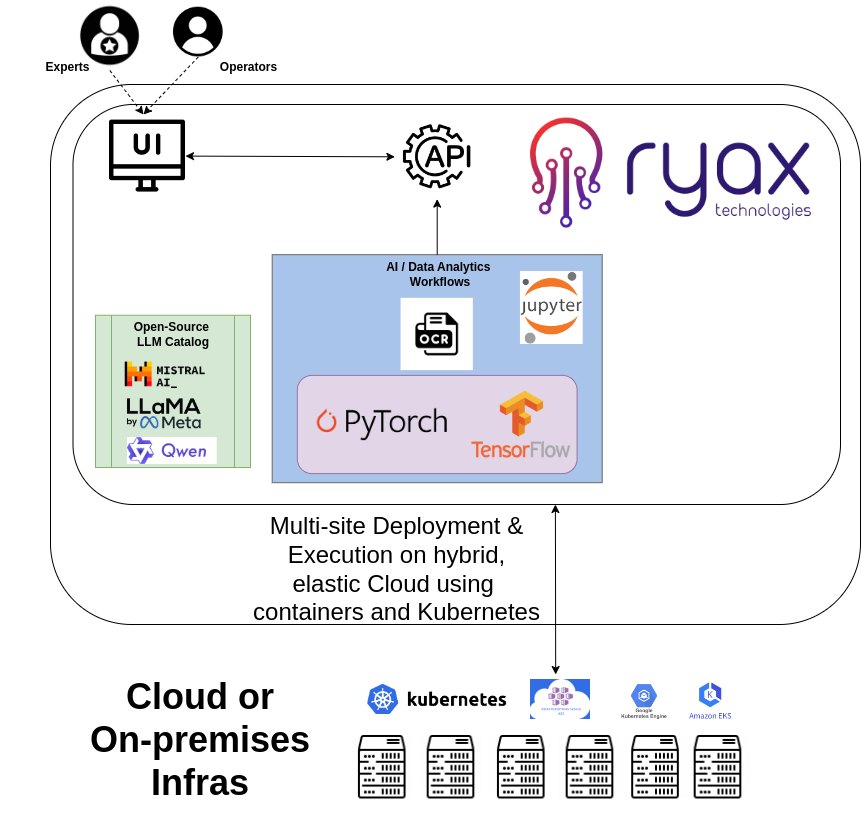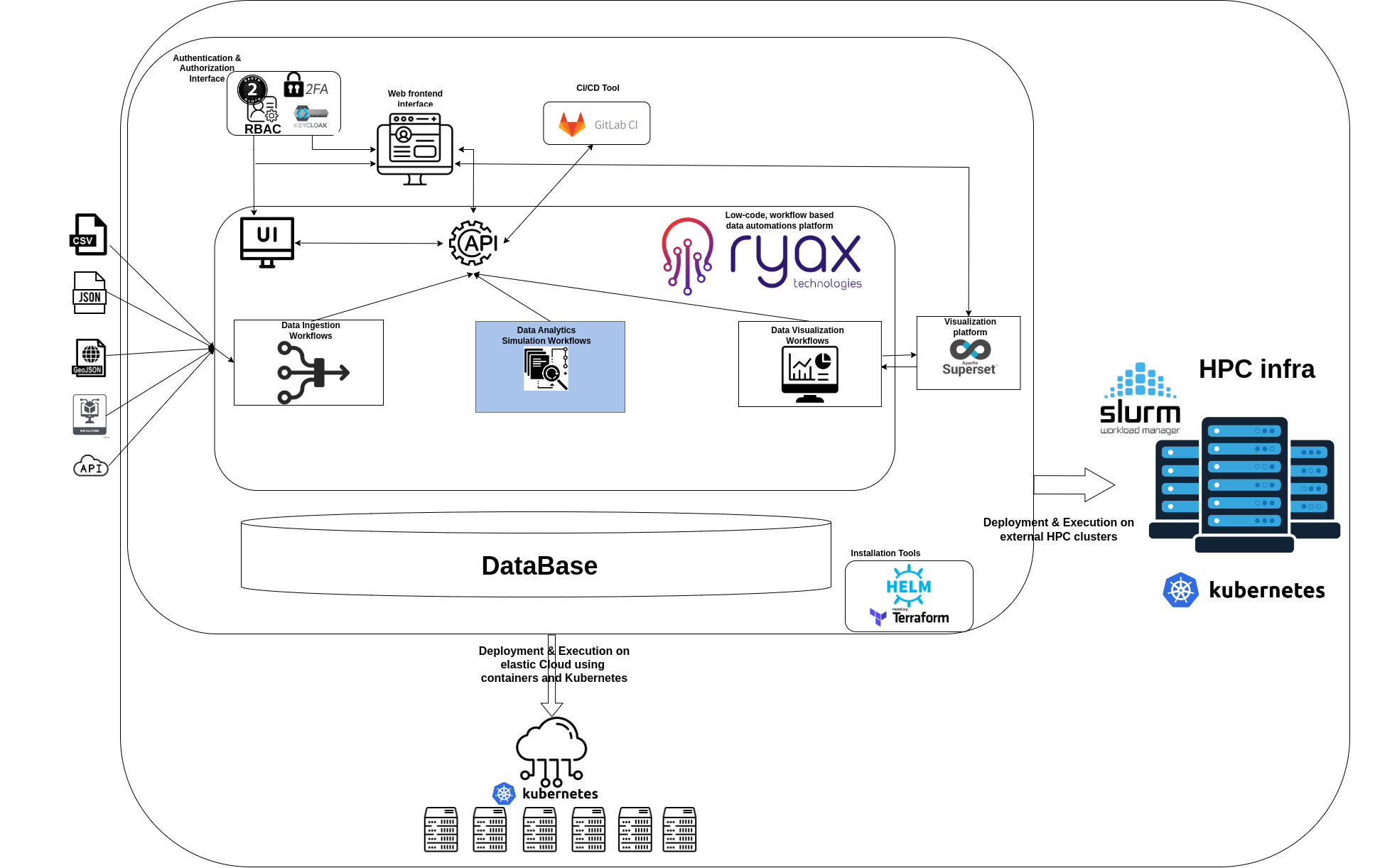Abstract
In an era of rapid digital transformation, enterprises face growing demands for efficient, scalable, and cost-effective data analytics and AI processing solutions. Ryax offers a next-generation compute and workflow orchestration platform designed for the execution of compute intensive apps upon diverse infrastructure environments, including Cloud, Edge, on-premises, and HPC. This whitepaper introduces Ryax key features, including its low-code interface, smart orchestration across the continuum, and AI-driven resources usage optimizations while presenting comparisons with alternative platforms and describing specific use cases. By enabling streamlined deployment, monitoring, and resource allocation for AI and data analytics workflows, Ryax empowers technical teams and industry stakeholders to optimize resource utilization, reduce costs, and boost performance across hybrid Cloud-HPC computing environments.
Introduction
The rise of data analytics and AI-driven applications has led to unprecedented computational demands. As these workloads grow in complexity, organizations struggle to maintain efficiency across multiple infrastructure environments while keeping costs and energy consumption under control. Ryax addresses these challenges by delivering a versatile and efficient compute and workflow management platform. Its advanced orchestration capabilities enable seamless execution of data analytics applications, including scientific simulations, ETL, AI and large language model (LLM) based workflows, by abstracting infrastructure complexities and optimizing resource utilization.

Problem Statement
Despite the rapid adoption of AI and data analytics solutions, many organizations face barriers to effective deployment and scaling:
- Application needs for diverse workloads: Modern applications exhibit diverse and demanding requirements related to combinations of ETL and data integration, AI/ML, Generative AI and LLM-based tasks along with scientific simulations need different types of hardware and adapted systems software to perform optimal executions.
- Infrastructure Complexity: Deploying and managing workloads across different environments (Cloud, Edge, HPC, on-prem) requires substantial resources and expertise.
- Resource Wastage and Cost Escalation: Inefficient use of CPUs, GPUs, and memory resources can lead to high operational costs and wasted computational power.
- Orchestration Challenges: Existing solutions often lack flexibility and transparency, leading to bottlenecks and reduced performance in workflow execution.
These challenges hinder innovation and scalability, making it essential for organizations to adopt a unified, efficient platform to support diverse workloads in an optimized manner.
Key Functionalities of Ryax
Environment Packaging and Abstraction
Ryax utilizes the NIX functional package manager to package environments, enabling users to easily bring code that Ryax then builds into containers across various architectures (e.g., x86, ARM, GPUs).
Hybrid Runtime Engine
With a custom serverless and microservices-based runtime engine, Ryax deploys AI, data analytics, and HPC applications across hybrid infrastructures, ensuring resource efficiency and scalability. This pay-as-you-go runtime supports any Kubernetes-based infrastructure.
Workflow Visualization and Control
Ryax provides an interface to view and control workflows, enabling users to manage workflows as connected components for easier design and efficient execution tracking.
Logging, Debugging, and Monitoring
Ryax offers built-in tools for logging, debugging, and monitoring, crucial for maintaining visibility and optimizing remote container executions across hybrid infrastructures.
Multi-constraint and multi-objective Scheduling
Ryax’s scheduling mechanism optimizes application execution through multi-constraint, multi-objective techniques, balancing resource allocation across environments like Cloud, Edge, and HPC.
Advanced Serverless Capabilities
The platform’s serverless framework enables CPU/GPU deployments across diverse infrastructures in a hardware-agnostic manner, supporting flexible usage of Kubernetes environments.
Multi-infras and HPC Offloading
Ryax facilitates the execution of compute-intensive data analytics tasks on high-performance computing resources by enabling offloading to external HPC schedulers, enhancing processing capabilities and unlocking new capabilities for workload diversification.
AI-driven resource optimizations
Ryax provides resource optimizations based on AI-driven techniques combining Kubernetes Vertical Pod Autoscaling, Bin Packing and Dynamic GPU Fractioning (such as NVIDIA MIG).
Related Work - Comparisons with alternatives
Current solutions in workflow and compute management offer partial solutions but often fall short in addressing the unique demands of hybrid infrastructure. Many workflow tools lack flexibility for low-code customization, seamless multi-site deployment, or real-time monitoring capabilities. Existing platforms often fail to provide sophisticated orchestration techniques like multi-objective scheduling or AI-powered optimizations for CPU/GPU usage. Ryax differentiates itself by integrating these capabilities into a single, scalable, and user-friendly platform designed specifically for data analytics and AI-driven workloads.
The field of AI and data analytics workflow orchestration has rapidly evolved, with several platforms offering specialized solutions tailored to specific use cases, infrastructure types, and technical requirements. This section compares Ryax to four notable platforms in this domain—Run.ai, Covalent, Kestra, and Iguazio—analyzing each in terms of orchestration capabilities, resource optimization, flexibility, and support for hybrid and multi-cloud infrastructure executions.
1) Run.ai
Run.ai is a leading orchestration platform focusing on optimizing AI and machine learning (ML) workloads, particularly for GPU resource allocation in high-performance computing environments. Run.ai provides GPU virtualization, enabling multiple AI workloads to share GPU resources, which is particularly useful in environments with heavy deep learning (DL) requirements. Like Ryax, Run.ai also supports Kubernetes-based infrastructure and offers dynamic resource allocation. However, Run.ai primarily targets GPU management and lacks broader workflow orchestration for multi-component applications or hybrid infrastructure.
In comparison, Ryax extends beyond GPU management by providing a full-fledged workflow orchestration platform that manages and optimizes executions not only on GPUs but also CPUs and memory resources across different types of infrastructure (Cloud, Edge, on-prem, HPC). Ryax’s smart orchestration combines multi-constraint and multi-objective scheduling, while Run.ai focuses on GPU-centric optimization, lacking the broader workflow and compute flexibility that Ryax offers.
Additionally, Ryax’s low-code, API-first design allows users to develop, deploy, and monitor complex workflows with minimal coding, integrating ETL, AI, and LLM-based workflows into a single, accessible platform. In contrast, Run.ai requires more technical expertise for setup and lacks the same degree of low-code functionality. This makes Ryax more versatile for teams with varying technical backgrounds who may need to manage diverse workloads beyond GPU-centric AI/ML tasks.
2) Covalent
Covalent is an open-source workflow orchestration tool designed to handle quantum computing and traditional HPC workloads. Covalent offers users a Python-based programming model to define workflows, with support for distributed and parallel computing, making it ideal for research-focused projects that leverage both quantum and classical computing resources. While Covalent provides a strong computational framework, its design is heavily focused on developers and research teams with specialized computational needs, offering less flexibility for hybrid infrastructure support.
In comparison, Ryax is purpose-built to facilitate data analytics, AI, and ML workloads across hybrid infrastructure environments, such as Cloud, Edge, and HPC. Unlike Covalent, which has a niche focus on quantum computing integration, Ryax supports diverse workload types and does so with an infrastructure-agnostic approach. This makes it highly adaptable for commercial and industrial applications where workflows might span multiple environments and include complex data and machine learning pipelines.
Another distinction is Ryax’s AI-driven resource optimization and multi-objective scheduling techniques. Covalent provides limited functionality in this area, focusing primarily on distributed computing rather than resource efficiency across a variety of hardware types. With Ryax’s multi-objective scheduling, users can optimize workflows based on performance, cost, and energy consumption, allowing for more fine-grained control over workload deployment.
3) Kestra
Kestra is an orchestration and automation platform for data workflows that emphasizes ETL pipelines and data management. Kestra supports integrations with popular data processing tools, making it valuable for data engineering teams needing robust ETL orchestration. Kestra’s key strength lies in its comprehensive suite of data-specific connectors and plugins, supporting tasks like data extraction, transformation, and loading from various sources. However, Kestra lacks advanced features for resource allocation, GPU utilization, and hybrid infrastructure management.
Ryax, in contrast, not only facilitates data workflow automation but also includes AI-driven orchestration capabilities designed for large-scale AI, ML, and LLM workflows. While Kestra provides a strong ETL foundation, it lacks support for high-performance GPU orchestration and hybrid infrastructure deployment. Ryax’s smart orchestration system optimizes workload distribution across hybrid environments, leveraging Kubernetes-based autoscaling, dynamic GPU fractioning, and bin packing techniques. These capabilities enable Ryax to efficiently manage compute resources across diverse applications, from traditional ETL to compute-intensive AI and ML models.
Furthermore, Ryax’s low-code UI and API-first design make it more accessible for users without extensive coding expertise, whereas Kestra requires a higher level of technical knowledge to configure and optimize workflows. Ryax’s focus on low-code accessibility and compute resource optimization provides a more comprehensive solution for organizations seeking both ETL capabilities and advanced AI/ML workflow management in a single platform.
4) Iguazio
Iguazio is a data science platform specifically designed for deploying and monitoring AI applications in production. It supports real-time data ingestion and analysis, making it suitable for edge computing and real-time AI solutions. Iguazio includes MLOps capabilities that help with the management of AI pipelines, model deployment, and real-time monitoring, making it effective for organizations with an operational AI focus. However, Iguazio primarily targets operational machine learning, and while it supports edge and cloud deployments, it does not provide the same flexibility in terms of workflow orchestration and infrastructure-agnostic deployment as Ryax.
Ryax offers a more expansive hybrid infrastructure support, designed to handle deployments across Cloud, Edge, on-prem, and HPC environments, without vendor lock-in. Its multi-site orchestration and multi-objective scheduling support complex AI/ML applications across varied infrastructure environments, while Iguazio is limited in its ability to orchestrate non-ML workloads or manage extensive resource allocation on HPC clusters. Ryax’s resource optimization capabilities, such as AI-driven bin packing and dynamic GPU fractioning, also surpass Iguazio’s offerings in terms of resource efficiency and versatility.
Another major differentiator is Ryax’s support for workflow views and intuitive design control, allowing users to view workflows as interconnected components, which simplifies complex workflow management. Iguazio’s focus on production AI workflows is well-suited for AI lifecycle management, but Ryax goes further in enabling diverse data automation and AI-driven applications by supporting both the development and operationalization of data workflows.
Summary of Comparisons
In summary, while each of these platforms provides unique capabilities, Ryax offers a more versatile and comprehensive solution for organizations needing to manage diverse data analytics, AI, and ML workflows. Key differentiators include:
-
Low-code Accessibility: Ryax’s low-code interface and API-first design enhance usability for non-technical users and speed up development.
-
Hybrid Infrastructure Support: Unlike competitors, Ryax supports seamless deployment across Cloud, Edge, on-prem, and HPC environments.
-
Advanced Resource Optimization: Ryax’s AI-driven resource optimization and smart orchestration techniques provide efficient workload distribution and cost savings.
-
Broader Workflow Orchestration: Ryax can manage complex data workflows and AI applications, making it suitable for mixed workloads and hybrid environments.
These distinctions make Ryax a strong choice for organizations looking for a platform that combines flexibility, ease of use, and infrastructure-agnostic orchestration for both data analytics and AI workloads.
Use Cases
Following are a few concrete examples of use cases leveraging Ryax platform
Fintech domain and Companies Financial Analysis
In this use case Ryax plays the role of the data-analytics platform to handle the different data treatment needed for the particular application. In particular, different workflows can be used to perform the extraction of specific metrics out of various financial documents. This can be offered based upon open-source Large Language Models using the serverless GPUs feature of Ryax and it can be deployed upon multiple sites to take advantage of powerful GPU node-pools.
Other Ryax workflows may perform the real-time ingestion and visualization of stock exchange data. Finally, both the frontend and the backend are deployed and hosted as services upon Ryax which can facilitate the work done by the operators of the application. The particular use case will show a substantial decrease for LLM utilization costs when compared to typical usage since the Serverless GPU technique allows the utilization of GPUs for only some minutes instead of complete hours.

Precision Medicine domain and Simulations-based applications
In this type of use case, Ryax can play a crucial role for the migration of an HPC application to the Cloud and hence offer unlimited elasticity to a rather rigid application. By adapting the application to run on Ryax platform it is transformed to an application which can be seamlessly executed on both Cloud and HPC types of infrastructures. This is becoming more and more interesting since applications incorporate AI/ML parts which are typically run on the Cloud but can also leverage HPC infras for performance benefits.
The application can be decomposed into different workflows from data ingestion getting data from different sources, to data visualization connecting with particular visualization platform, along with the more compute-intensive ones related to precision medicine statistical simulations which can be all controlled through Ryax platform. Furthermore different types of databases can be used to store the data in their different stages and this database can be either deployed on the underlying Kubernetes cluster or used as a service from an already deployed and externally managed provider. Finally Ryax can be used to host the frontend user interface and enable communications with the backend through the REST-API endpoints which can be created to control the different data analytic workflows.

Conclusions
Ryax’s innovative platform is uniquely suited for organizations aiming to maximize the efficiency, scalability, and performance of their data analytics and AI workloads. By combining low-code workflow management, smart orchestration, and advanced resource optimization, Ryax empowers organizations to handle complex data-driven applications across diverse infrastructures with greater flexibility and reduced cost. Ryax stands out as an essential tool for industry stakeholders, technical teams, and clients looking to unlock the full potential of their data processing capabilities in a streamlined, powerful, and sustainable way.
